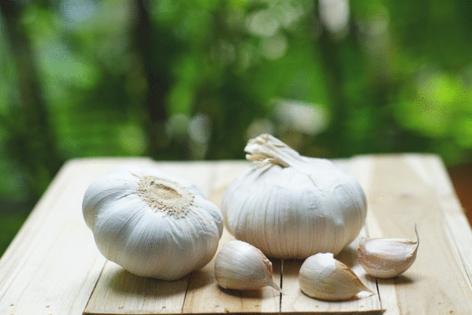Column: Growing your own garlic is like a breath of fresh air
Published in Variety Menu
ST. LOUIS -- Anne Carpenter did not grow up in a family that ate garlic. But now she’s something of an evangelist for it.
“Clearly, people know there is a value to home-grown tomatoes. I’m trying to show that there is a value to home-grown garlic,” she says.
Home-grown garlic is so sweet and juicy and mild when it comes out of the ground that you can eat it like a vegetable, she says.
“If you look at books, they say to cure it” — hang it up to dry — “for several weeks before eating. I like to eat it right then and there,” she says, admitting to being something of a rebel on this and many other matters.
Carpenter, 59, owns the cooking school and kitchen store the Kitchen Conservatory in Brentwood, Missouri. Much of St. Louis still knows her as Anne Cori; she was widowed before she remarried a year and a half ago following a whirlwind romance.
She grows a substantial amount of garlic in a large garden plot at her home — “substantial amount” being 2,400 heads. What she doesn’t cook and eat at home, she sells at her store.
She charges $2.99 a head. It’s a reasonable price, she says, considering all of the time and effort that goes into growing them. Most garlic in the stores comes from China, where labor is cheap, she says.
Like her, you can grow it yourself.
Each head of garlic begins as a clove, which has to be planted by hand — stem side up, root side down — in about 3 inches of dirt. She plants hers 8 inches apart in all directions, in order to get the biggest and best heads. And because “garlic is a heavy eater,” she adds some compost to the soil that she grows it in.
Carpenter plants her garlic in October, before the ground freezes. During the fall, green shoots will grow to around 6 to 8 inches high. In the winter, the plants go dormant; they like a cold winter, she says.
She fertilizes her plants after the last frost of winter, and a few weeks later they can be harvested for spring garlic.
With spring garlic, the bulbs are smaller than they become when they are mature, but they are also sweeter and milder. Spring garlic is like scallions, she says, because you can eat the whole stalk.
Of course, if you harvest the plant for spring garlic you won’t end up with the more traditional, mature bulbs.
Toward the end of May, it is vitally important to remove the garlic scapes, the tender shoot and flower bud that grows from the middle of the stalk. Keeping the bud from flowering by cutting them off assures that more energy goes to the bulb and not to the flower.
As an added benefit, scapes are delicious, she says. Mild in flavor, they are wonderful in stir-fries, sautéed or added as a topping to pizza.
Carpenter harvests her garlic in June, which is a little earlier than most garlic growers. Traditionally, garlic is grown according to holidays: It’s planted on Columbus Day, the scapes are picked on Memorial Day and the bulbs are harvested on the Fourth of July.
She prefers hardneck garlic to softneck, and the difference is more than just how stiff or soft the stem is above the bulb. Hardneck yields one row of large cloves around the center stem. Softneck garlic yields several rows of small cloves that get smaller as they get closer to the center. Only hardneck garlic has scapes.
Hardneck garlic is sweeter and juicier, she says, though she admits that may be because the softneck is stored longer, which makes it dryer and more bitter.
Unless it is going to be eaten immediately, garlic should be hung for a few weeks to dry, usually the stalks tied together in groups of 20 or 30. And while garlic is sold year-round in stores, Carpenter pushes it aside after it reaches a certain point.
“Fresh garlic is going to be good for six months. After that, I’m not interested in eating it,” she says.
It’s like tomatoes, she says. After the tomato season is over, the pale, flavorless tomatoes that are sold in stores are not worth eating.
And the absence only makes her garlic-loving heart grow fonder.
“When it’s back in season, I’m hungry to eat garlic because I haven’t eaten it in several months.”
Garlic Soup
Yield: 4-6 servings
Ingredients
1 head of garlic, peeled
Olive oil, as needed
1 quart chicken stock
Salt and pepper, to taste
3 egg yolks
1 cup heavy cream
Grated Parmesan cheese
Chopped herbs for garnish, such as parsley, thyme and/or tarragon
Directions
Preheat oven to 275 degrees. Place the garlic in a ramekin and cover with olive oil. Bake for 30 minutes, or until very tender. Remove the garlic from the oil and mash with a fork; you can reserve the garlic-flavored oil for other uses.
Place the mashed garlic, stock, salt and pepper in a medium pot over medium heat, and bring to a boil. Whisk together the yolks and the cream in a bowl.
Add 1 tablespoon of the hot stock to the cream mixture, while stirring constantly. Keep stirring while you add another tablespoon of the stock to the cream mixture, and then another and another until you have added about ¼ of the stock to the cream.
Pour the cream mixture back into the stock and whisk constantly until slightly thickened. Do not let the soup come to a boil. Stop cooking when the temperature reaches 180 degrees. Add cheese and herbs, and serve.
Recipe by Anne Carpenter
©2024 STLtoday.com. Distributed by Tribune Content Agency, LLC.










Comments